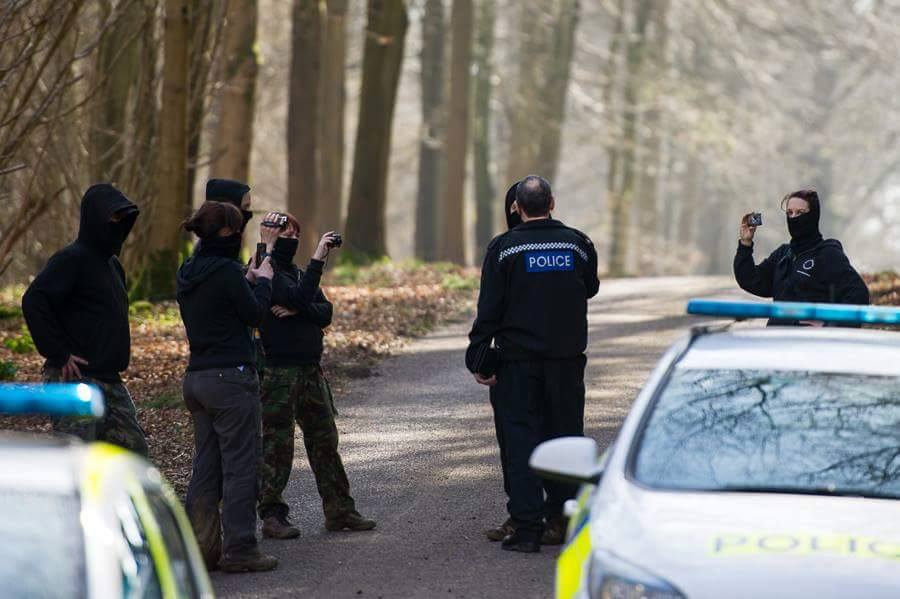
Public Order Act 1986
Section 1 - Riot
(1) Where 12 or more persons who are present together use or threaten unlawful violence for a common purpose and the conduct of them (taken together) is such as would cause a person of reasonable firmness present at the scene to fear for his personal safety, each of the persons using unlawful violence for the common purpose is guilty of riot.
(2) It is immaterial whether or not the 12 or more use or threaten unlawful violence simultaneously.
(3) The common purpose may be inferred from conduct.
(4) No person of reasonable firmness need actually be, or be likely to be, present at the scene.
(5) Riot may be committed in private as well as in public places.
(6) A person guilty of riot is liable on conviction on indictment to imprisonment for a term not exceeding 10 years or a fine, or both.
Section 2 - Violent Disorder
(1) Where three or more persons who are present together use or threaten unlawful violence and the conduct of them (taken together) is such as would cause a person of reasonable firmness present at the scene to fear for his personal safety, each of the persons using or threatening unlawful violence is guilty of violent disorder.
(2) It is immaterial whether or not the three or more use or threaten unlawful violence simultaneously.
(3) Same as Section 1
(4) Same as Section 1
(5) A person guilty of violent disorder is liable on conviction on indictment to imprisonment for a term not exceeding 5 years or a fine, or both, or on summary conviction to imprisonment for a term not exceeding six months or a fine not exceeding the statutory maximum or both.
Section 3 - Affray
(1) A person is guilty of affray if they use or threatens unlawful violence towards another and his conduct is such as would cause a person of reasonable firmness present at the scene to fear for his personal safety.
(2) Where two or more persons use or threaten the unlawful violence, it is the conduct of them taken together that must be considered for the purposes of subsection (1)
(3) For the purposes of this section words cannot be made by the use of words alone.
(4) Same as Section 1
(5) Same as Section 1
(6) A constable may arrest without warrant anyone he reasonably suspects is committing affray
(7) A person guilty of affray is liable on conviction on indictment to imprisonment for a term not exceeding three years or a fine or both, or on summary conviction to imprisonment for a term not exceeding six months or a fine not exceeding the statutory maximum or both.
Section 4 - Fear or provocation of violence
(1) A person is guilty of an offence if he - a) uses towards another person threatening, abusive or insulting words or behaviour, or b) distributes or displays to another person any writing, sign or other visible representation which is threatening, abusive or insulting, with intent to cause that person to believe that immediate unlawful violence will be used against him or another by any person, or to provoke the immediate use of unlawful violence by that person or another, or whereby that person is likely to believe that such violence will be provoked
(2) An offence under this section may be committed in a public or a private place, except that no offence is committed where the words or behaviour are used, or the writing, sign or other visible representation is distributed or displayed, by a person inside a dwelling and the other person is also inside that or another dwelling.
(3) A constable may arrest without warrant anyone he reasonably suspects is committing on offence under this subsection
(4) A person guilty of an offence under this section is liable on summary conviction to imprisonment for a term not exceeding six months or a fine not exceeding level 5 on the standard scale or both.
Section 5 - Harassment, alarm or distress
(1) A person is guilty of an offence if he - a) uses threatening, abusive or insulting words or behaviour, or disorderly behaviour. or b) displays any writing, sign or other visible representation which is threatening, abusive or insulting, within the hearing or sight of a person likely to be caused harassment, alarm or distress thereby
(2) An offence under this section may be committed in a public or a private place, except that no offence is committed where the words or behaviour are used, or the writing, sign or other visible representation is displayed, by a person inside a dwelling and the other person is also inside that or another dwelling.
(3) It is a defence for the accused to prove - a) That he had no reason to believe that there was any person within hearing or sight who was likely to be caused harassment, alarm or distress, or b) That he was inside a dwelling and had no reason to believe that the words or behaviour used, or the writing, sign or other visible representation displayed, would be heard or seen by a person outside that or any other dwelling, or c) That his conduct was reasonable
(4) A constable may arrest without warrant if - a) He engages in offensive conduct which the constable warns him to stop, and b) He engages in further offensive conduct immediately or shortly after the warning
(5) In subsection (4) above 'offensive conduct' means conduct the constable reasonably suspects to constitute an offence under this section, and the conduct mentioned in paragraph (a) and the further conduct need not be of the same nature
(6) A person guilty of an offence under this section is liable on summary conviction to a fine not exceeding level 3 on the standard scale.

